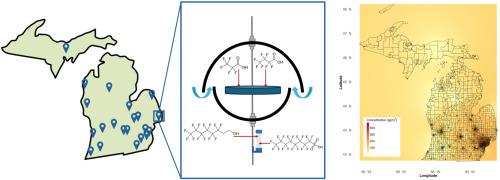Atmospheric concentrations of per- and polyfluoroalkyl substances in Michigan's ambient air using passive sampling
IF 3.7
2区 环境科学与生态学
Q2 ENVIRONMENTAL SCIENCES
引用次数: 0
Abstract
As a part of Michigan's efforts to identify and address per- and polyfluoroalkyl substances (PFAS) contamination statewide, more knowledge of atmospheric PFAS concentrations is needed to better understand their atmospheric transport and impact on other environmental media. This research aimed to measure atmospheric concentrations of PFAS in Michigan's ambient air using low-cost and easy-to-use passive samplers and identify relationships with environmental factors. Passive samplers, consisting of polyurethane foam (PUF) discs and sorbent-filled polyethylene tubes (radiello-XAD samplers), were deployed for a month at 27 sites across Michigan and analyzed for both ionic and volatile, neutral PFAS. Short chain perfluorocarboxylic acids (PFCAs), specifically perfluoropropanoic acid (PFPrA) (d.f. 60 %) and perfluorobutanoic acid (PFBA) (d.f. 96 %), and perfluorooctane sulfonic acid (PFOS) (d.f. 63 %) were the most frequently detected compounds, with the ∑3PFAS ranging from non-detect to 15.5 pg/m3 for the PUFs and from non-detect to 248 pg/m3 in the radiello-XAD samplers. 6:2 fluorotelomer alcohol was also frequently detected (d.f. 45 %) and had a positive correlation with both population density (r = 0.52, p < .05) and industrial sites' density (r = 0.48, p < .05). Detection of specific compounds on each type of sampler provided insight into the preferential transport pathway of atmospheric PFAS. For example, PFOS was observed mostly in the gas-phase, predominantly captured by the radiello-XAD samplers, while PFBA was mostly in the particle-phase, predominantly captured by the PUFs. This study highlights the importance of developing detection tools for measuring atmospheric PFAS across a vast geographic area to identify contributing factors to ambient concentrations.

采用被动采样法测定密歇根州环境空气中全氟烷基和多氟烷基物质的大气浓度
作为密歇根州在全州范围内查明和处理全氟烷基和多氟烷基物质污染的努力的一部分,需要更多地了解大气中全氟烷基物质的浓度,以便更好地了解它们在大气中的迁移及其对其他环境介质的影响。本研究旨在使用低成本和易于使用的被动采样器测量密歇根州环境空气中PFAS的大气浓度,并确定其与环境因素的关系。被动采样器由聚氨酯泡沫(PUF)盘和填充吸附剂的聚乙烯管(radilo - xad采样器)组成,在密歇根州的27个地点部署了一个月的时间,分析了离子和挥发性中性PFAS。短链全氟羧酸(PFCAs),特别是全氟丙烷酸(PFPrA)(60%)和全氟丁酸(PFBA)(96%)和全氟辛烷磺酸(PFOS)(63%)是最常检测到的化合物,其中puf的∑3PFAS从未检测到15.5 pg/m3, radielo - xad样品的∑3PFAS从未检测到至248 pg/m3。6:2氟端聚物酒精也经常被检测到(d.f为45%),并且与人口密度(r = 0.52, p < 0.05)和工业场所密度(r = 0.48, p < 0.05)呈正相关。通过对每种采样器上特定化合物的检测,可以深入了解大气PFAS的优先转运途径。例如,全氟辛烷磺酸主要处于气相,主要被radilo - xad采样器捕获,而PFBA主要处于颗粒相,主要被puf捕获。这项研究强调了开发检测工具的重要性,这些工具可以在广阔的地理区域内测量大气PFAS,以确定影响环境浓度的因素。
本文章由计算机程序翻译,如有差异,请以英文原文为准。
求助全文
约1分钟内获得全文
求助全文
来源期刊

Atmospheric Environment
环境科学-环境科学
CiteScore
9.40
自引率
8.00%
发文量
458
审稿时长
53 days
期刊介绍:
Atmospheric Environment has an open access mirror journal Atmospheric Environment: X, sharing the same aims and scope, editorial team, submission system and rigorous peer review.
Atmospheric Environment is the international journal for scientists in different disciplines related to atmospheric composition and its impacts. The journal publishes scientific articles with atmospheric relevance of emissions and depositions of gaseous and particulate compounds, chemical processes and physical effects in the atmosphere, as well as impacts of the changing atmospheric composition on human health, air quality, climate change, and ecosystems.
 求助内容:
求助内容: 应助结果提醒方式:
应助结果提醒方式:


